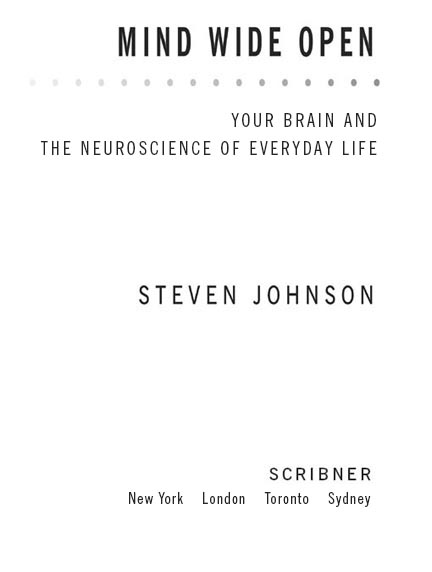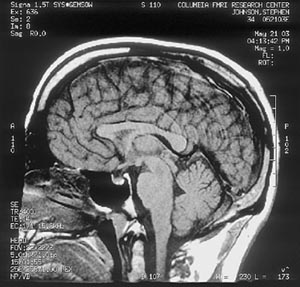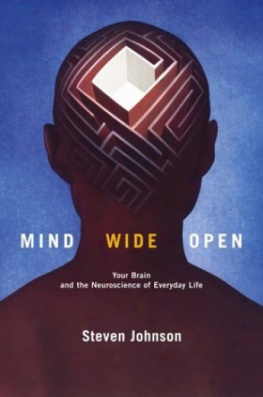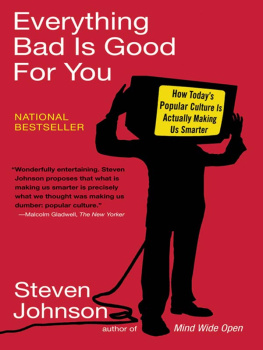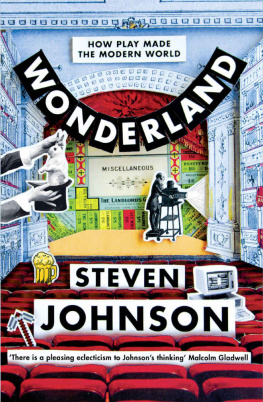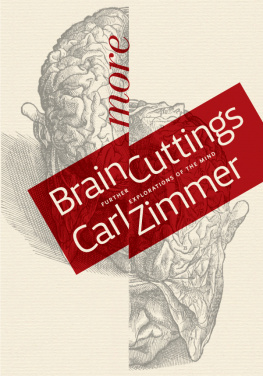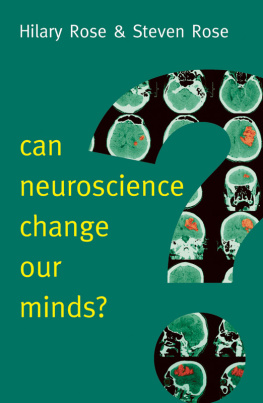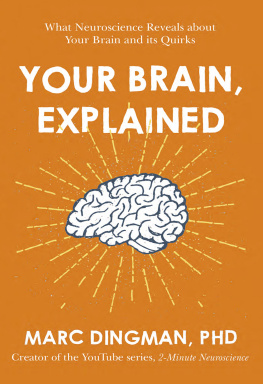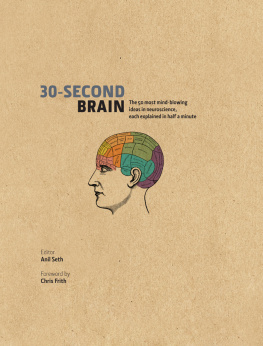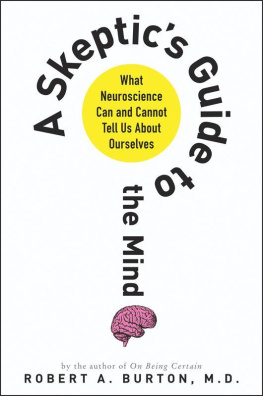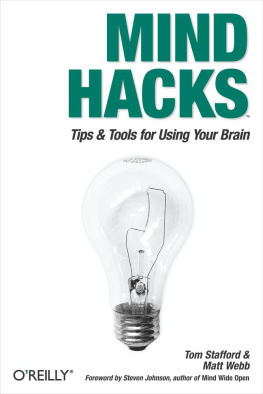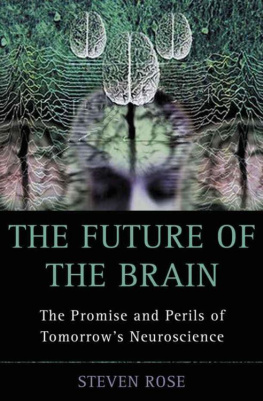SCRIBNER
1230 Avenue of the Americas
New York, NY 10020
Copyright 2004 by Steven Johnson
All rights reserved, including the right of reproduction in whole or in part in any form.
SCRIBNER and design are trademarks of
Macmillan Library Reference USA, Inc., used under license
by Simon amp; Schuster, the publisher of this work.
Designed by Kyoko Watanabe
Text set in Adobe Caslon
Library of Congress Cataloging-in-Publication Data
Johnson, Steven.
Mind wide open: your brain and the neuroscience of everyday life/ Steven Johnson.
p. cm.
Includes bibliographical references and index.
1. Neurosciences. 2. Neuropsychology. 3. Self-perception. I. Title.
RC341.J648 2004
612.82-dc22
2003063308
ISBN 0-7432-5879-7
Portions of this book first appeared in Discover Magazine and The Nation.
Reading the Mind in the Eyes test and images used by permission of Simon Baron-Cohen. The test first appeared in the Journal of Child Psychology and Psychiatry, 1997. The Reading the Mind in the Eyes test is based on photographs from commercial sources. The test itself is used only for research and is not distributed for commercial profits. Copyright of each individual photograph cannot be traced from these photo fragments.
Visit us on the World Wide Web:
For my boys
let winged Fancy wander
Through the thought still spread beyond her:
Open wide the minds cage-door
KEATS
Contents
The authors brain, seen through a conventional MRI scan.
Preface Kafkas Room
How pathetically scanty my self-knowledge is compared with, say, my knowledge of my room There is no such thing as observation of the inner world, as there is of the outer world.
KAFKA
The idea for this book began with a nervous joke-a handful of nervous jokes, to be precise. A few years ago, thanks to a lucky convergence of events and a long-standing curiosity, I found myself in the office of a biofeedback practitioner, lying on a couch with sensors attached to my palms, fingertips, and forehead. As we talked, the two of us stared into a computer monitor, where a series of numbers flashed on the screen like some kind of low-budget version of the CNBC ticker tape. The numbers documented precisely how much I was sweating and updated several times a second. Ive never taken a lie detector test, but something about having a stranger ask me questions while keeping a close eye on my sweat glands put me on edge. And so I started making jokes.
Getting a little tense was partly the point of the exercise. The machine I was attached to was tracking changes in my adrenaline levels, the fight-or-flight hormone secreted by the adrenal glands in situations that require a sudden surge of energy. Increased adrenaline can be detected through a number of means: because the hormone diverts blood from the extremes of the body to the core, drops in temperature at the extremities often suggest a release of adrenaline (hence the sensors on my fingertips). Sweating is also a telltale sign of heightened adrenaline levels. Because damp skin conducts electricity more effectively than dry skin, the electrodes on my palms could track how much I was sweating by monitoring changes in conductivity over time.
Biofeedback systems are designed to give you a new kind of control over your body and mind by making physiological changes visible in a new way. After a few sessions, biofeedback users learn to drive their adrenaline levels up or down almost as though they were deciding to lift a finger or bend a knee. The brain, of course, is constantly adjusting adrenaline levels anyway-its just that youre not usually aware of the process other than as a background sense of increased energy or calm.
For the first five minutes of the session, my adrenaline levels remained at the midpoint of the scrolling chart, bouncing around ever so slightly, but with no real pronounced variation. And then something in the situation-I cant remember now what it was-caused me to make an offhand joke. We both chuckled at my remark and then noticed that a huge spike had appeared on the monitor. Making the joke had triggered a surge of adrenaline in me. Or was it the reverse? Perhaps the rise in adrenaline was me mentally revving the engines before launching my joke into the environment. Whatever the causal chain, my joke-telling and my adrenaline levels were locked in some kind of chemical embrace.
The extent of that link became clear at the end of our session, when the therapist handed me a printout of my adrenaline levels plotted over our thirty-minute encounter. It was, simply put, a time-line of my attempts at humor: a flat line interrupted by five or six dramatic spikes. I looked at that paper and thought: Ive caught a glimpse of me here, viewed from an angle that Ive never experienced before. Id known for many years that I had a tendency to crack jokes compulsively in certain social situations, particularly in situations where the formality of the setting made humor a riskier bet. But Id never thought about those jokes as triggering a chemical reaction in my own head. Suddenly, they seemed less like casual attempts at humor and more like a drug addicts hungering for a new fix.
I knew those adrenaline surges were just the tip of the iceberg. The creation and appreciation of humor is a remarkably complex neurological event, involving many parts of the brain and a host of chemical messengers. Doctors at the University of California Medical School, for example, recently located a small region near the front of the left brain that appears to trigger the feeling of mirth; while treating a sixteen-year-old epileptic patient, they applied a tiny jolt of electric current to the area, which caused the patient to find humor in whatever she happened to be looking at. This wasnt merely a physical reflex of laughter: things genuinely seemed funny to her when the region was stimulated. (You guys are just so funny-standing around, she told her startled doctors.) Laughter itself involves a complex array of muscle actions, and there is increasing evidence that it triggers the release of small amounts of endorphins, the brains natural painkillers. (The next time you visit a comedy club, think opium den.) But making jokes in conversation also requires a subtle sense of ones audience, a feel for their sense of humor and state of mind. Such outer-directed imagination is itself governed by another part of the brain, a part believed to be damaged in autistics and that accounts for their strained social interactions.
This is what came to my mind as I thought about my nervous jokes on the biofeedback practitioners couch: that with each of those jokes somewhere in my head there was an elaborate electrochemical ballet unfolding, one that had been evolving since my first smile, or before. And now I had glimpsed a subsection of that inner performance as it happened. I found myself wondering how many of these little chemical subroutines are running in my brain on any given day? At any given moment? And what would it tell me about myself if I could see them, the way I could see those adrenaline spikes on the printout?
Next page
